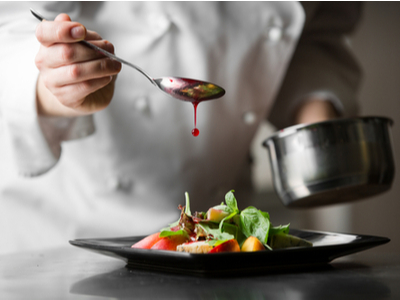July was designated as National Culinary Arts Month, a time when we acknowledge the art genre of chefs, cooks, bakers and others who engage in culinary endeavors. So pull up a plate of your favorite food, sit back with your favorite online casino slots real money game and enjoy blissful relaxation as you pay homage to the positive impact that food artists have on our lives.
Culinary Arts
According to the Escoffier School of Culinary Arts, “culinary arts” refers to “ the preparation, cooking, plating, presentation, and service of food. It applies to meals and their components – like appetizers, side dishes, and main courses – rather than desserts or breads.” Expert chefs need to be well-versed in food sciences, diet and nutrition as well as how to prepare meals that are pleasing both to the eye and to the palate. After a course of study that can range from several months to several years, chefs who practice culinary art may find work in high-end restaurants, hotels or even as private caterers.
In addition to a knowledge of ingredients, spices, herbs, cooking times, sauces and other food-related subjects, a culinary arts specialist must also understand kitchen utensils (batterie de cuisine) and implements as well as cooking techniques and technologies.
Cooking and serving the food is as much of an art as is any other kind of creative endeavor and the people who established the National Culinary Arts Month have pushed ahead to have the public recognize these contributions.
Celebration
You don’t have to be a 5-star Michelin chef to celebrate Culinary Arts Month. Try some simple but elegant recipes, serve them with a flair and you’ll be participating in National Culinary Arts Month with a bang.
Some sophisticated, easy, delectable, stunningly beautiful, and mouth-watering recipes to try include:
Mackerel with Celery and Green Olive Dressing
Mackerel is an oily fish and can spoil quickly. You should buy it fresh on the day that you intend to use it. You can determine that it’s fresh by pink or bright-red gills and bright eyes. This recipe pickles, rather than cooks the fish but it also leaves you with a relatively smell-free kitchen.
To prepare the fish, lay the fish in a shallow dish with the skin down. Sprinkle it with 1 ½ Tbsp. flaky salt and half a teaspoon of fennel seeds. Cover the fish evenly, lay some cling film over the pan and refrigerate it for 1 hour. After the hour, remove it and wash the fish clean. Pat it dry with a paper towel and return the fish to the shallow dish with the skin side up. Pour ¼ cup olive oil and scatter half a cup of shallots.
Boil 1 Tbsp white sugar with 1 Tbsp red wine vinegar and juice of half a lemon. Pour over the fish while the liquid is hot and let cool. Marinate the fish in this liquid in the refrigerator overnight.
Serve the fish at room temperature covered with olives, celery and celery leaves. Lemon wedges should border the fish on the plate along with a few spoonfuls of crème fraiche.
Haloumi and Zucchini Skillet Fritter
Haloumi cheese is an increasingly popular specialty cheese that is made of sheep’s or goat’s milk. It is a traditional cheese served on the Mediterranean island of Cyprus that is similar to mozzarella. It is an unripened, brined cheese with a tangy and salty taste and spongy texture. You can eat Haloumi raw but when melted it adds flavor and texture to any dish as it becomes crispy and savory on the outside while it melts sensually on the inside.
Haloumi can be paired with any number of vegetables (and even some fruits) but if you want an elegant yet easy-to-prepare dish, try the Haloumi and Zucchini Skillet Fritter.
Grate 500 grams of haloumi and mix it with a kilo of grated zucchini which you have squeezed to get rid of the extra water. Place both grated ingredients in a bowl and add a bunch of chopped chives, keeping some chives on the side for the topping.
Add half a cup of self-rising flour and 2 eggs. Heat olive oil in a frying pan and lay the mixture out like a pancake. Fry it until it starts to set and then turn it over and fry on the other side (approximately 3 minutes per side).
Place the fritter on a plate and top with flakes of fresh, baked salmon, crème fraiche and leaves of baby rocket. Place lemon wedges around the side and serve.
Bruschetta
If you’re clever and creative you can make any number of different types of bruschettas and impress your guests without putting forth any great effort.
Bruschetta is, basically, toasted bread, drenched in olive oil and served with toppings such as tomatoes. Much depends on the type of bread that’s used to ensure that you get a good hearty meal but beyond that, the toppings can take any form from cheeses, baked vegetables or even fruits.
Best to use a hearty bread or baguette which you can load up with olive oil and toppings.
Some of the more inventive and visually stunning bruschetta toppings include
- Gorgonzola cheese with purple grapes laid on top with honey drizzled over everything.
- Ricotta cheese with roasted figs laid on top and a basil leaf topping the colorful presentation.
- Goat cheese topped by herbed olive tapenade.
- Sautéed mushrooms.
- Applies, brie and honey.
- Creamy ricotta, salty prosciutto topped with sweet cherries.






